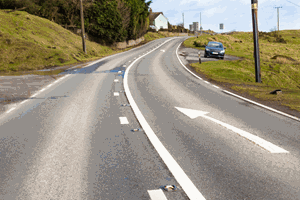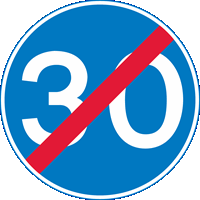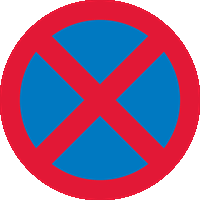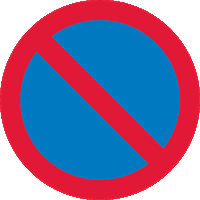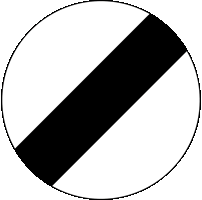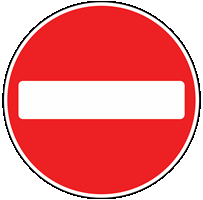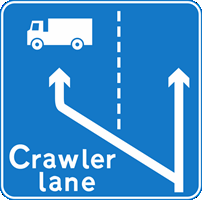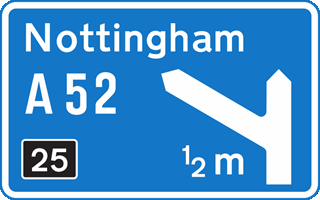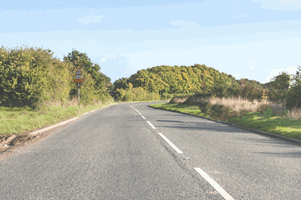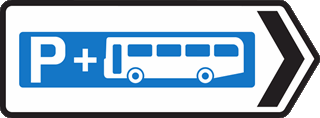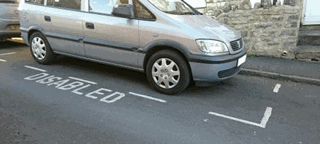You have 57 minutes to answer 50 multiple choice driving theory test questions. You need to answer at least 43 out of 50 questions correctly to pass. You can review your answer after each question or you can review all of your answers at the end of the test. Best of luck!
Test Quick View
Click on an answer to view the correct choice along with the explanation.
Correct Answer: B
Explanation: You should plan your overtaking to take into account any hazards ahead. In this picture the marking indicates that you are approaching a junction. You will not have time to overtake and move back into the left safely.
Explanation: You should plan your overtaking to take into account any hazards ahead. In this picture the marking indicates that you are approaching a junction. You will not have time to overtake and move back into the left safely.
آپ کو اوورٹیکنگ کرتے ہوئے خطرات کو مدنظر رکھنا چاہئے۔ اس تصویر میں نشانات یہ ظاہر کرتے ہیں کہ آپ جب جنکشن پر پہنچ رہے ہیں آپ کے پاس اوورٹیک کرنے اور بحفاظت بائیں طرف واپس جانے کا ٹائم نہیں ہوگا۔
Correct Answer: A
Explanation: This sign indicates that the road will bend sharply to the left. Slow down in plenty of time and select the correct gear before you start to turn. Braking hard and late, while also sharply changing direction, is likely to cause a skid.
Explanation: This sign indicates that the road will bend sharply to the left. Slow down in plenty of time and select the correct gear before you start to turn. Braking hard and late, while also sharply changing direction, is likely to cause a skid.
3. You're turning left into a side road. What hazard should you be especially aware of? Mark one answer
AB
C
D
Correct Answer: C
Explanation: Make sure that you've reduced your speed and are in the correct gear for the turn. Look into the road before you turn and always give way to any pedestrians who are crossing.
Explanation: Make sure that you've reduced your speed and are in the correct gear for the turn. Look into the road before you turn and always give way to any pedestrians who are crossing.
Correct Answer: B
Explanation: The red slash through the sign indicates that the restriction has ended. In this case, the restriction was a minimum speed limit of 30 mph.
Explanation: The red slash through the sign indicates that the restriction has ended. In this case, the restriction was a minimum speed limit of 30 mph.
Correct Answer: D
Explanation: Look for and obey traffic signs. Disobeying or not seeing a sign could be dangerous. It may also be an offence for which you could be prosecuted.
Explanation: Look for and obey traffic signs. Disobeying or not seeing a sign could be dangerous. It may also be an offence for which you could be prosecuted.
Correct Answer: B
Explanation: Where there's a long, steep, uphill gradient on a motorway, a crawler lane may be provided. This helps the traffic to flow by diverting the slower heavy vehicles into a dedicated lane on the left.
Explanation: Where there's a long, steep, uphill gradient on a motorway, a crawler lane may be provided. This helps the traffic to flow by diverting the slower heavy vehicles into a dedicated lane on the left.
Correct Answer: B
Explanation: Before you set out on your journey, use a road map to plan your route. When you see an advance warning of your junction, make sure you get into the correct lane in plenty of time. Last-minute harsh braking and cutting across lanes at speed is extremely hazardous.
Explanation: Before you set out on your journey, use a road map to plan your route. When you see an advance warning of your junction, make sure you get into the correct lane in plenty of time. Last-minute harsh braking and cutting across lanes at speed is extremely hazardous.
8. You've broken down on a motorway. In which direction should you walk to find the nearest emergency telephone? Mark one answer
AB
C
D
Correct Answer: C
Explanation: Along the hard shoulder there are marker posts at 100-metre intervals. These will direct you to the nearest emergency telephone.
Explanation: Along the hard shoulder there are marker posts at 100-metre intervals. These will direct you to the nearest emergency telephone.
Correct Answer: C
Explanation: Hazard warning lights are fitted to all modern cars and some motorcycles. They should be used to warn
- other road users when your vehicle is causing a temporary obstruction; for example, after a collision or when it's broken down
- following drivers on a motorway of a hazard or obstruction ahead.
They shouldn't be used as an excuse for dangerous or illegal parking.
Explanation: Hazard warning lights are fitted to all modern cars and some motorcycles. They should be used to warn
- other road users when your vehicle is causing a temporary obstruction; for example, after a collision or when it's broken down
- following drivers on a motorway of a hazard or obstruction ahead.
They shouldn't be used as an excuse for dangerous or illegal parking.
Correct Answer: D
Explanation: If you're planning to make a journey when it's foggy, listen to the weather reports. If visibility is very poor, avoid making unnecessary journeys. If you do travel, leave plenty of time - and if someone is waiting for you to arrive, let them know that your journey will take longer than normal. This will also take off any pressure you may feel to rush.
Explanation: If you're planning to make a journey when it's foggy, listen to the weather reports. If visibility is very poor, avoid making unnecessary journeys. If you do travel, leave plenty of time - and if someone is waiting for you to arrive, let them know that your journey will take longer than normal. This will also take off any pressure you may feel to rush.
Correct Answer: C
Explanation: The centre of the road is usually marked by a broken white line, with lines that are shorter than the gaps. When the lines become longer than the gaps, this is a hazard warning line. Look well ahead for these, especially when you're planning to overtake or turn off.
Explanation: The centre of the road is usually marked by a broken white line, with lines that are shorter than the gaps. When the lines become longer than the gaps, this is a hazard warning line. Look well ahead for these, especially when you're planning to overtake or turn off.
12. A slow-moving lorry showing this sign is travelling in the middle lane of a three-lane motorway. How should you pass it? Mark one answer
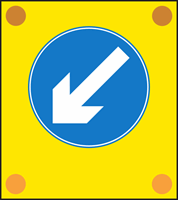
B
C
D
Correct Answer: A
Explanation: This sign is found on slow-moving or stationary works vehicles. If you wish to overtake, do so on the left, as indicated. Be aware that there might be workmen in the area.
Explanation: This sign is found on slow-moving or stationary works vehicles. If you wish to overtake, do so on the left, as indicated. Be aware that there might be workmen in the area.
13. You're following a large vehicle. Why should you stay a safe distance behind it? Mark one answer
AB
C
D
Correct Answer: A
Explanation: If you're following a large vehicle but are so close to it that you can't see its exterior mirrors, the driver won't be able to see you. Keeping well back will also allow you to see the road ahead by looking past on either side of the large vehicle.
Explanation: If you're following a large vehicle but are so close to it that you can't see its exterior mirrors, the driver won't be able to see you. Keeping well back will also allow you to see the road ahead by looking past on either side of the large vehicle.
Correct Answer: A
Explanation: In some built-up areas, you may find the speed limit reduced to 20 mph. Driving at a slower speed will help give you the time and space to see and deal safely with hazards such as pedestrians and other vulnerable road users.
Explanation: In some built-up areas, you may find the speed limit reduced to 20 mph. Driving at a slower speed will help give you the time and space to see and deal safely with hazards such as pedestrians and other vulnerable road users.
Correct Answer: D
Explanation: Note that this is the typical stopping distance. It will take at least this distance to think, brake and stop in good conditions. In poor conditions, it will take much longer.
Explanation: Note that this is the typical stopping distance. It will take at least this distance to think, brake and stop in good conditions. In poor conditions, it will take much longer.
Correct Answer: A
Explanation: Although cars are the least likely to be affected, side winds can take anyone by surprise. This is most likely to happen after overtaking a large vehicle, when passing gaps between hedges or buildings, and on exposed sections of road.
Explanation: Although cars are the least likely to be affected, side winds can take anyone by surprise. This is most likely to happen after overtaking a large vehicle, when passing gaps between hedges or buildings, and on exposed sections of road.
Correct Answer: B
Explanation: To ease the congestion in town centres, some cities and towns provide park-and-ride schemes. These allow you to park in a designated area and ride by bus into the centre. Park-and-ride schemes are usually cheaper and easier than car parking in the town centre.
Explanation: To ease the congestion in town centres, some cities and towns provide park-and-ride schemes. These allow you to park in a designated area and ride by bus into the centre. Park-and-ride schemes are usually cheaper and easier than car parking in the town centre.
18. At a railway level crossing, the red lights continue to flash after a train has gone by. What should you do? Mark one answer
AB
C
D
Correct Answer: D
Explanation: You must always obey red flashing stop lights. If a train passes but the lights continue to flash, another train will be passing soon. Cross only when the lights go off and the barriers open.
Explanation: You must always obey red flashing stop lights. If a train passes but the lights continue to flash, another train will be passing soon. Cross only when the lights go off and the barriers open.
19. It can be helpful to plan your route before starting a journey. Why should you also plan an alternative route? Mark one answer
AB
C
D
Correct Answer: D
Explanation: It can be frustrating and worrying to find your planned route is blocked by roadworks or diversions. If you've planned an alternative, you'll feel less stressed and more able to concentrate fully on your driving or riding. If your original route is mostly on motorways, it's a good idea to plan an alternative using non-motorway roads. Always carry a map with you just in case you need to refer to it.
Explanation: It can be frustrating and worrying to find your planned route is blocked by roadworks or diversions. If you've planned an alternative, you'll feel less stressed and more able to concentrate fully on your driving or riding. If your original route is mostly on motorways, it's a good idea to plan an alternative using non-motorway roads. Always carry a map with you just in case you need to refer to it.
20. You're making an appointment and will have to travel a long distance. How should you plan for the journey? Mark one answer
AB
C
D
Correct Answer: A
Explanation: Always allow plenty of time for your journey in case of unforeseen problems. Anything can happen; for example, punctures, breakdowns, road closures, diversions and delays. You'll feel less stressed and less inclined to take risks if you aren't 'pushed for time'.
Explanation: Always allow plenty of time for your journey in case of unforeseen problems. Anything can happen; for example, punctures, breakdowns, road closures, diversions and delays. You'll feel less stressed and less inclined to take risks if you aren't 'pushed for time'.
Correct Answer: B
Explanation: Police officers may need to direct traffic; for example, at a junction where the traffic lights have broken down. Check your copy of The Highway Code for the signals that they use.
Explanation: Police officers may need to direct traffic; for example, at a junction where the traffic lights have broken down. Check your copy of The Highway Code for the signals that they use.
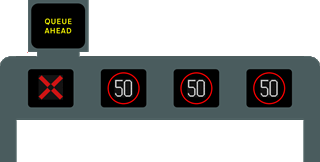
B
C
D
Correct Answer: D
Explanation: A red cross above the hard shoulder shows that it's closed as a running lane and should only be used for emergencies or breakdowns. On a smart motorway, the hard shoulder may be used as a running lane at busy times. This will be shown by a mandatory speed limit on the gantry above the hard shoulder.
Explanation: A red cross above the hard shoulder shows that it's closed as a running lane and should only be used for emergencies or breakdowns. On a smart motorway, the hard shoulder may be used as a running lane at busy times. This will be shown by a mandatory speed limit on the gantry above the hard shoulder.
23. Following a collision, someone has suffered a burn. The burn needs to be cooled. What's the shortest time it should be cooled for? Mark one answer
AB
C
D
Correct Answer: C
Explanation: Check the casualty for shock and, if possible, try to cool the burn for at least 20 minutes. Use a clean, cool, non-toxic liquid, preferably water.
Explanation: Check the casualty for shock and, if possible, try to cool the burn for at least 20 minutes. Use a clean, cool, non-toxic liquid, preferably water.
Correct Answer: A
Explanation: You must produce a valid insurance certificate when requested by a police officer. If you can't do this immediately, you may be asked to take it to a police station. Other documents you may be asked to produce are your driving licence and the vehicle's MOT certificate.
Explanation: You must produce a valid insurance certificate when requested by a police officer. If you can't do this immediately, you may be asked to take it to a police station. Other documents you may be asked to produce are your driving licence and the vehicle's MOT certificate.
Correct Answer: D
Explanation: Depending on relative speed, it will usually take you longer to pass a lorry than other vehicles. Hazards to watch for include oncoming traffic, junctions ahead, bends or dips that could restrict your view, and signs or road markings that prohibit overtaking. Make sure you can see that it's safe to complete the manoeuvre before you start to overtake.
Explanation: Depending on relative speed, it will usually take you longer to pass a lorry than other vehicles. Hazards to watch for include oncoming traffic, junctions ahead, bends or dips that could restrict your view, and signs or road markings that prohibit overtaking. Make sure you can see that it's safe to complete the manoeuvre before you start to overtake.
26. You're travelling along a motorway and feel tired. Where should you stop to rest? Mark one answer
AB
C
D
Correct Answer: A
Explanation: If you feel tired, stop at the nearest service area. If that's too far away, leave the motorway at the next exit and find a safe place to stop. You mustn't stop on the carriageway or hard shoulder of a motorway except in an emergency, when in a traffic queue, or when signalled to do so by a police officer, a traffic officer or traffic signals. Plan your journey so that you have regular rest stops.
Explanation: If you feel tired, stop at the nearest service area. If that's too far away, leave the motorway at the next exit and find a safe place to stop. You mustn't stop on the carriageway or hard shoulder of a motorway except in an emergency, when in a traffic queue, or when signalled to do so by a police officer, a traffic officer or traffic signals. Plan your journey so that you have regular rest stops.
Correct Answer: B
Explanation: Slow down and be ready to stop if you see animals in the road ahead. Animals are easily frightened by noise and vehicles passing too close to them. Stop if signalled to do so by the person in charge.
Explanation: Slow down and be ready to stop if you see animals in the road ahead. Animals are easily frightened by noise and vehicles passing too close to them. Stop if signalled to do so by the person in charge.
28. In heavy motorway traffic, the vehicle behind you is following too closely. How can you lower the risk of a collision? Mark one answer
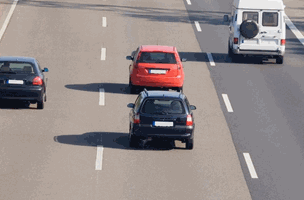
B
C
D
Correct Answer: B
Explanation: On busy roads, traffic may still travel at high speeds despite being close together. Don't follow the vehicle in front too closely. If a driver behind seems to be 'pushing' you, gradually increase your distance from the vehicle in front by slowing down gently. This will give you more space in front if you have to brake, and will reduce the risk of a collision involving several vehicles.
Explanation: On busy roads, traffic may still travel at high speeds despite being close together. Don't follow the vehicle in front too closely. If a driver behind seems to be 'pushing' you, gradually increase your distance from the vehicle in front by slowing down gently. This will give you more space in front if you have to brake, and will reduce the risk of a collision involving several vehicles.
29. At an incident, someone is suffering from severe burns. What should you do to help them? Mark one answer
AB
C
D
Correct Answer: C
Explanation: Your priority is to cool the burns with a clean, cool, non-toxic liquid, preferably water. Its coolness will help take the heat out of the burns and relieve the pain. Keep the wound doused for at least 10 minutes. If blisters appear, don't attempt to burst them, as this could lead to infection.
Explanation: Your priority is to cool the burns with a clean, cool, non-toxic liquid, preferably water. Its coolness will help take the heat out of the burns and relieve the pain. Keep the wound doused for at least 10 minutes. If blisters appear, don't attempt to burst them, as this could lead to infection.
30. At night, you see a pedestrian wearing reflective clothing and carrying a bright red light. What does this mean? Mark one answer
AB
C
D
Correct Answer: C
Explanation: The people on the walk should be keeping to the left, but don't assume this. Pass carefully, making sure you have time to do so safely. Be aware that the pedestrians have their backs to you and may not know that you're there.
Explanation: The people on the walk should be keeping to the left, but don't assume this. Pass carefully, making sure you have time to do so safely. Be aware that the pedestrians have their backs to you and may not know that you're there.
31. You're driving along this road. The red van cuts in close in front of you. What should you do? Mark one answer
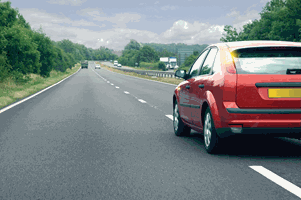
B
C
D
Correct Answer: B
Explanation: There are times when other drivers make incorrect or ill-judged decisions. Be tolerant and try not to retaliate or react aggressively. Always consider the safety of other road users, your passengers and yourself.
Explanation: There are times when other drivers make incorrect or ill-judged decisions. Be tolerant and try not to retaliate or react aggressively. Always consider the safety of other road users, your passengers and yourself.
Correct Answer: D
Explanation: Brakes can overheat and lose efficiency when they're used continually, such as on a long, steep, downhill stretch of road. Using a lower gear when you drive downhill can help prevent the vehicle from gaining speed.
Explanation: Brakes can overheat and lose efficiency when they're used continually, such as on a long, steep, downhill stretch of road. Using a lower gear when you drive downhill can help prevent the vehicle from gaining speed.
33. You're testing your suspension. You notice that your vehicle keeps bouncing when you press down on the front wing. What does this mean? Mark one answer
AB
C
D
Correct Answer: C
Explanation: If you find that your vehicle bounces as you drive around a corner or bend in the road, the shock absorbers might be worn. Press down on the front wing and, if the vehicle continues to bounce, take it to be checked by a qualified mechanic.
Explanation: If you find that your vehicle bounces as you drive around a corner or bend in the road, the shock absorbers might be worn. Press down on the front wing and, if the vehicle continues to bounce, take it to be checked by a qualified mechanic.
A
B
C
D
B
C
D
Correct Answer: B
Explanation: You've shown that you're a risk to yourself and others on the road. For this reason, insurance companies may charge you a higher premium.
Explanation: You've shown that you're a risk to yourself and others on the road. For this reason, insurance companies may charge you a higher premium.
A
B
C
D
B
C
D
Correct Answer: D
Explanation: Long-distance driving can be boring. This, coupled with a stuffy, warm vehicle, can make you feel tired and sleepy. Make sure you take rest breaks to help you stay awake and alert. Stop in a safe place before you get to the stage of fighting sleep.
Explanation: Long-distance driving can be boring. This, coupled with a stuffy, warm vehicle, can make you feel tired and sleepy. Make sure you take rest breaks to help you stay awake and alert. Stop in a safe place before you get to the stage of fighting sleep.
36. You're driving over a level crossing. The warning lights come on and a bell rings. What should you do? Mark one answer
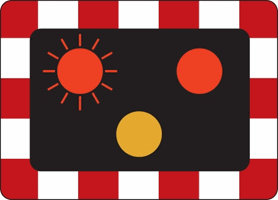
B
C
D
Correct Answer: B
Explanation: Keep going; don't stop on the crossing. If the amber warning lights come on as you're approaching the crossing, you must stop unless it's unsafe to do so. Red flashing lights together with an audible signal mean you must stop.
Explanation: Keep going; don't stop on the crossing. If the amber warning lights come on as you're approaching the crossing, you must stop unless it's unsafe to do so. Red flashing lights together with an audible signal mean you must stop.
37. You're on a busy main road and find that you're travelling in the wrong direction. What should you do? Mark one answer
AB
C
D
Correct Answer: C
Explanation: Don't turn around in a busy street or reverse from a side road into a main road. Find a quiet side road and choose a place where you won't obstruct an entrance or exit. Look out for pedestrians and cyclists as well as other traffic.
Explanation: Don't turn around in a busy street or reverse from a side road into a main road. Find a quiet side road and choose a place where you won't obstruct an entrance or exit. Look out for pedestrians and cyclists as well as other traffic.
Correct Answer: D
Explanation: Your fog lights must only be used when visibility is reduced to 100 metres (328 feet) or less. You need to be familiar with the layout of your dashboard so you're aware if your fog lights have been switched on in error, or you've forgotten to switch them off.
Explanation: Your fog lights must only be used when visibility is reduced to 100 metres (328 feet) or less. You need to be familiar with the layout of your dashboard so you're aware if your fog lights have been switched on in error, or you've forgotten to switch them off.
Correct Answer: C
Explanation: Drive extremely carefully when the roads are icy. When travelling on ice, tyres make virtually no noise and the steering feels light and unresponsive. In icy conditions, be very gentle when braking, accelerating and steering.
Explanation: Drive extremely carefully when the roads are icy. When travelling on ice, tyres make virtually no noise and the steering feels light and unresponsive. In icy conditions, be very gentle when braking, accelerating and steering.
Correct Answer: D
Explanation: Never leave the vehicle registration document inside your car. This document would help a thief to dispose of your car more easily.
Explanation: Never leave the vehicle registration document inside your car. This document would help a thief to dispose of your car more easily.
41. You've just been overtaken by this motorcyclist, who has cut in sharply. What should you do? Mark one answer

B
C
D
Correct Answer: C
Explanation: If another vehicle cuts in sharply, ease off the accelerator and drop back to allow a safe separation distance. Try not to overreact by braking sharply or swerving, as you could lose control. If vehicles behind you are too close or unprepared, it could lead to a crash.
Explanation: If another vehicle cuts in sharply, ease off the accelerator and drop back to allow a safe separation distance. Try not to overreact by braking sharply or swerving, as you could lose control. If vehicles behind you are too close or unprepared, it could lead to a crash.
42. You're about to drive home. You can't find the glasses you need to wear. What should you do? Mark one answer
AB
C
D
Correct Answer: D
Explanation: If you need to wear glasses for driving, it's illegal to drive without them. You must be able to see clearly when you're driving.
Explanation: If you need to wear glasses for driving, it's illegal to drive without them. You must be able to see clearly when you're driving.
Correct Answer: D
Explanation: If you're driving on a motorway at night or in poor visibility, you must always use your headlights, even if the road is well lit. Other road users must be able to see you, but you should avoid causing dazzle.
Explanation: If you're driving on a motorway at night or in poor visibility, you must always use your headlights, even if the road is well lit. Other road users must be able to see you, but you should avoid causing dazzle.
44. You're driving through a tunnel and the traffic is flowing normally. What should you do? Mark one answer
AB
C
D
Correct Answer: A
Explanation: Before entering a tunnel, you should switch on your dipped headlights, as this will allow you to see and be seen. In many tunnels, it's a legal requirement. Don't wear sunglasses while driving in a tunnel. You may wish to tune your radio to a local channel for traffic information.
Explanation: Before entering a tunnel, you should switch on your dipped headlights, as this will allow you to see and be seen. In many tunnels, it's a legal requirement. Don't wear sunglasses while driving in a tunnel. You may wish to tune your radio to a local channel for traffic information.
A
B
C
D
B
C
D
Correct Answer: A
Explanation: In a collision, rapid deceleration will violently throw vehicle occupants forward and then backwards as the vehicle stops. Seat belts and airbags protect occupants against the forward movement. Head restraints should be adjusted so they give maximum protection to the head and neck during the backward movement.
Explanation: In a collision, rapid deceleration will violently throw vehicle occupants forward and then backwards as the vehicle stops. Seat belts and airbags protect occupants against the forward movement. Head restraints should be adjusted so they give maximum protection to the head and neck during the backward movement.
46. What can people who live or work in towns and cities do to help reduce urban pollution levels? Mark one answer
AB
C
D
Correct Answer: D
Explanation: Using a vehicle for short journeys means the engine doesn't have time to reach its normal operating temperature. When an engine is running below its normal operating temperature, it produces increased amounts of pollution. Walking and cycling don't create pollution and have health benefits as well.
Explanation: Using a vehicle for short journeys means the engine doesn't have time to reach its normal operating temperature. When an engine is running below its normal operating temperature, it produces increased amounts of pollution. Walking and cycling don't create pollution and have health benefits as well.
47. You're driving towards a zebra crossing. A person in a wheelchair is waiting to cross. What should you do? Mark one answer
AB
C
D
Correct Answer: A
Explanation: You should slow down and be prepared to stop, as you would for an able-bodied person. Don't wave them across, as other traffic may not stop.
Explanation: You should slow down and be prepared to stop, as you would for an able-bodied person. Don't wave them across, as other traffic may not stop.
A
B
C
D
B
C
D
Correct Answer: A
Explanation: Towing a large trailer or caravan can greatly reduce your view of the road behind. You may need to fit extended-arm side mirrors so that you can see clearly behind and down both sides of the caravan or trailer.
Explanation: Towing a large trailer or caravan can greatly reduce your view of the road behind. You may need to fit extended-arm side mirrors so that you can see clearly behind and down both sides of the caravan or trailer.
Correct Answer: A
Explanation: Don't park in a space reserved for disabled people unless you or your passenger are a disabled badge holder. The badge must be displayed in your vehicle, in the bottom left-hand corner of the windscreen.
Explanation: Don't park in a space reserved for disabled people unless you or your passenger are a disabled badge holder. The badge must be displayed in your vehicle, in the bottom left-hand corner of the windscreen.
50. You lose control of your car and damage a garden wall. No-one is around. What must you do? Mark one answer
AB
C
D
Correct Answer: C
Explanation: If the property owner isn't available at the time, you must inform the police about the incident. This should be done as soon as possible, and in any case within 24 hours.
Explanation: If the property owner isn't available at the time, you must inform the police about the incident. This should be done as soon as possible, and in any case within 24 hours.



